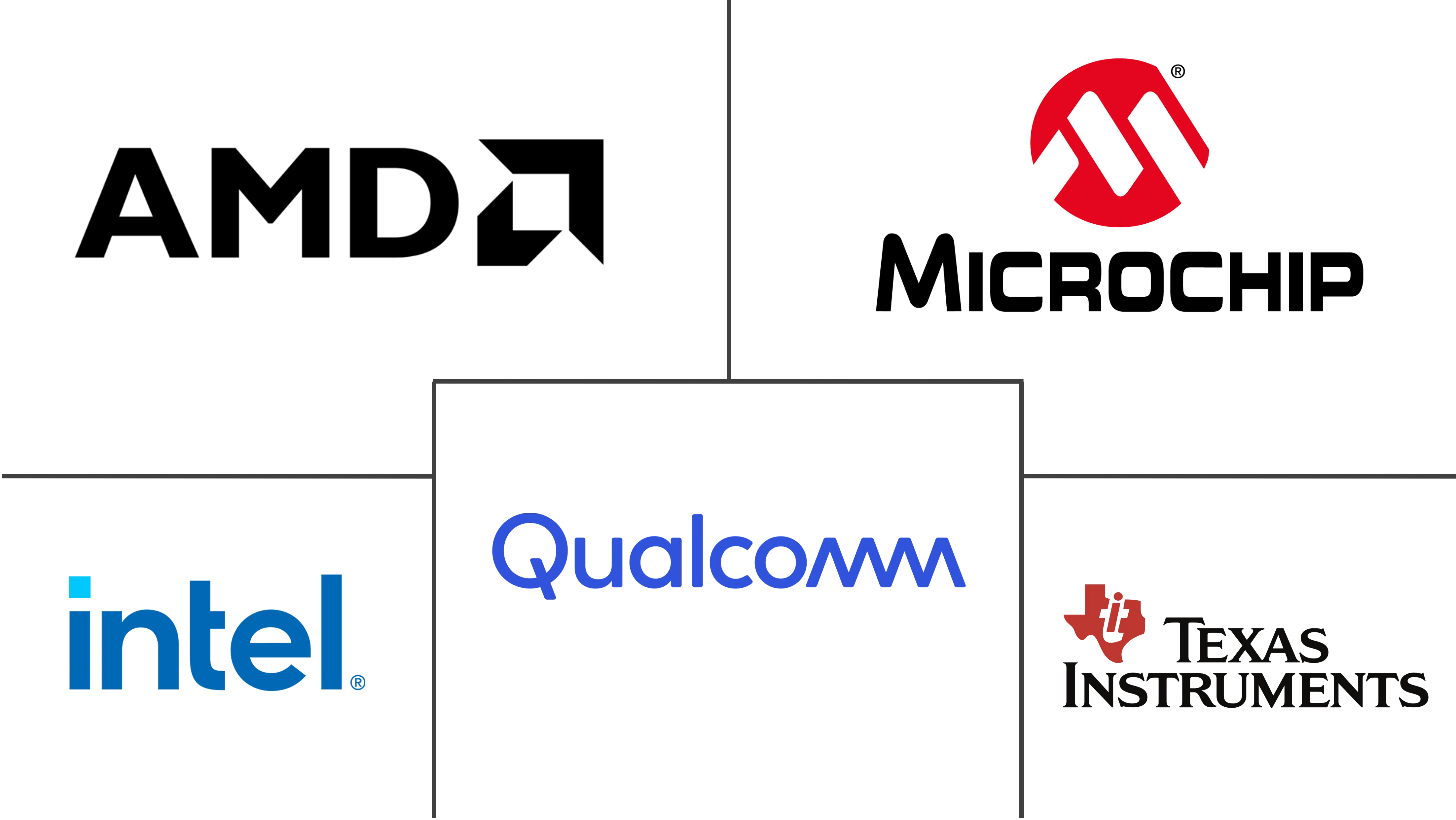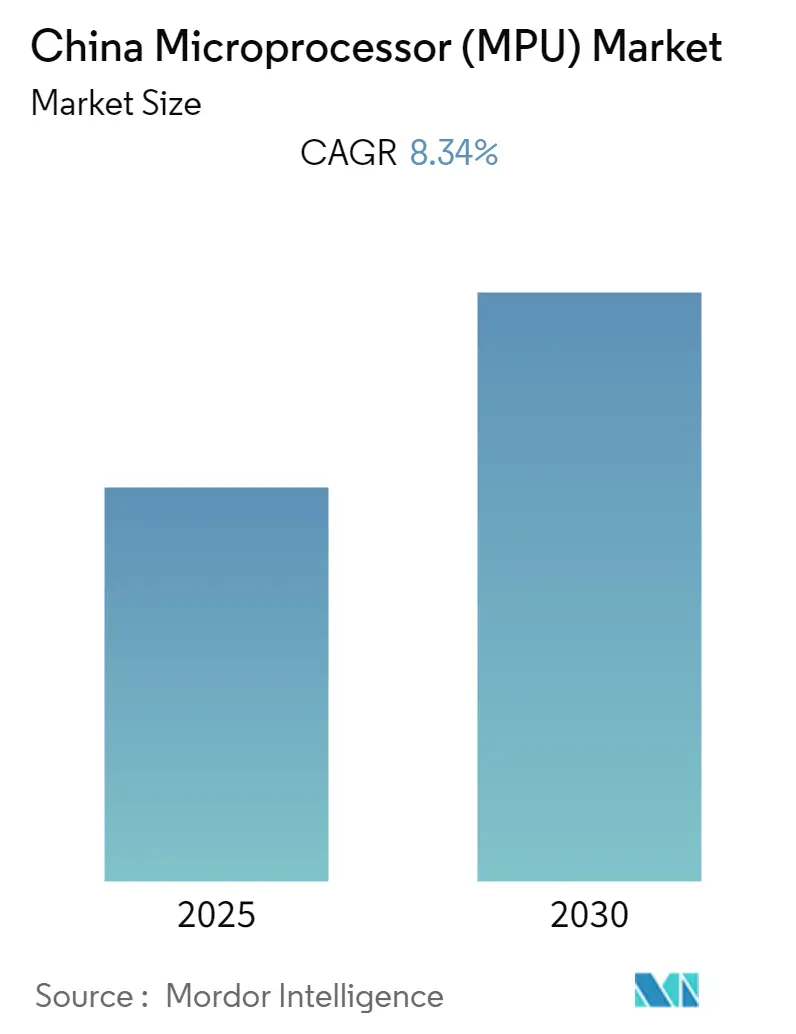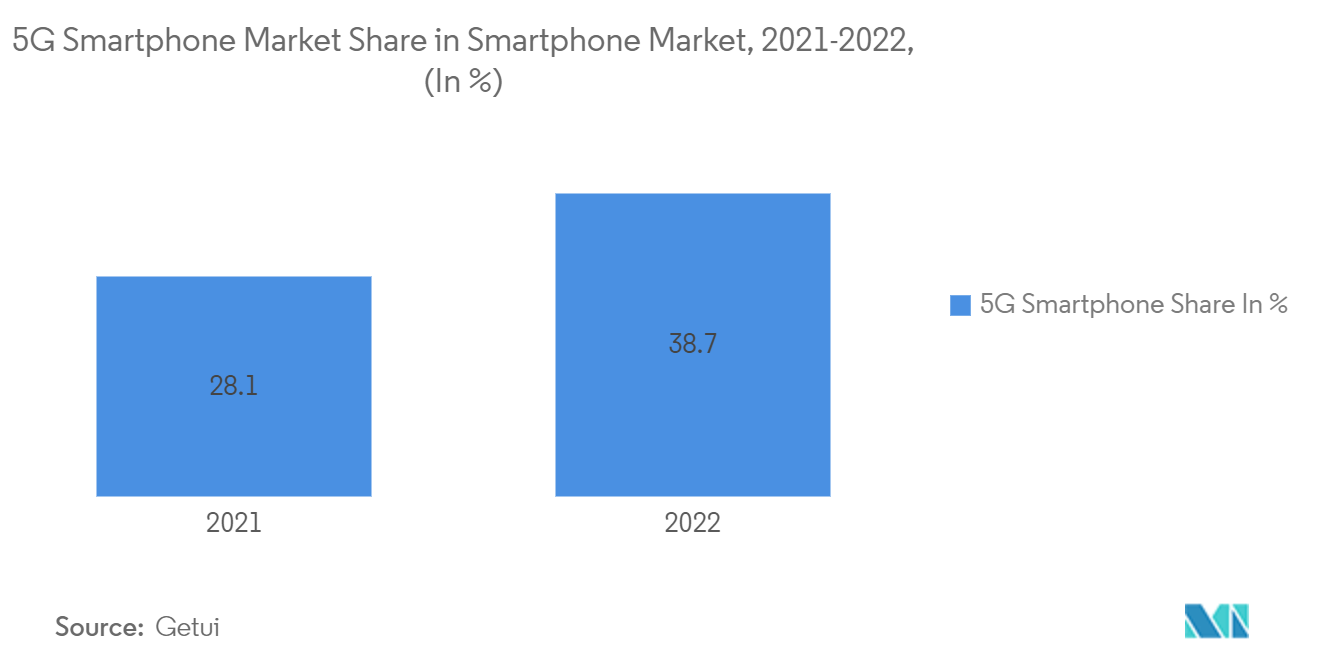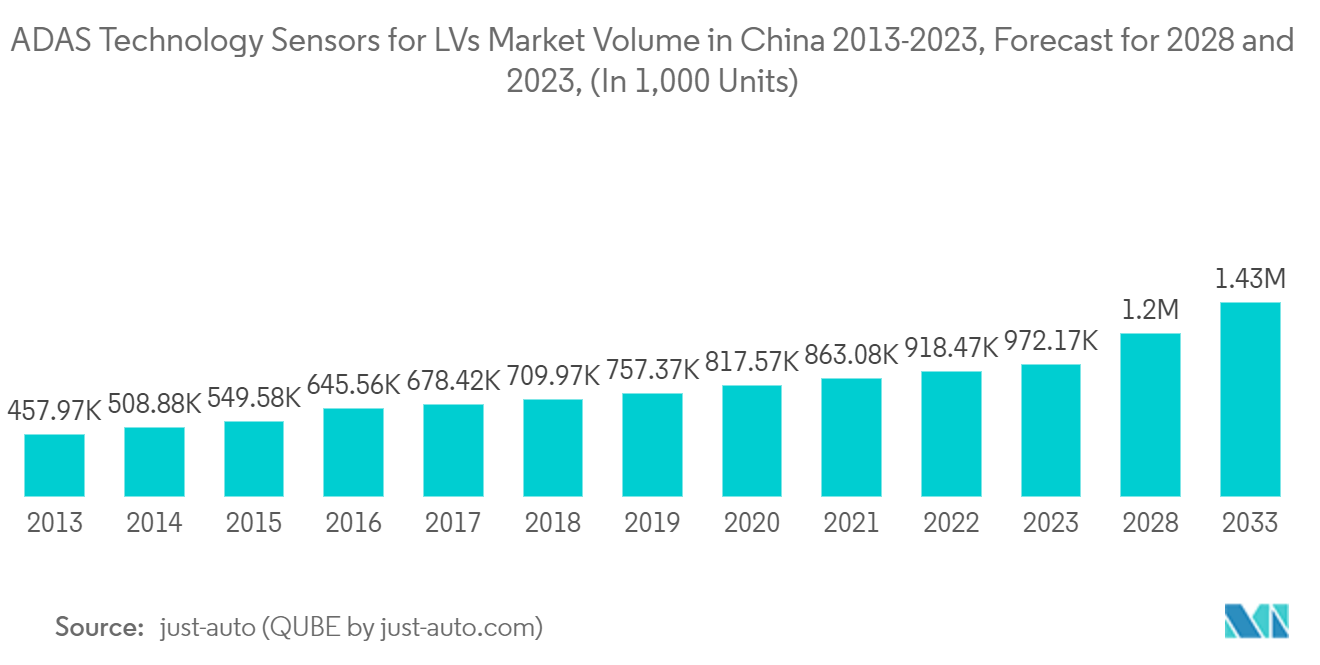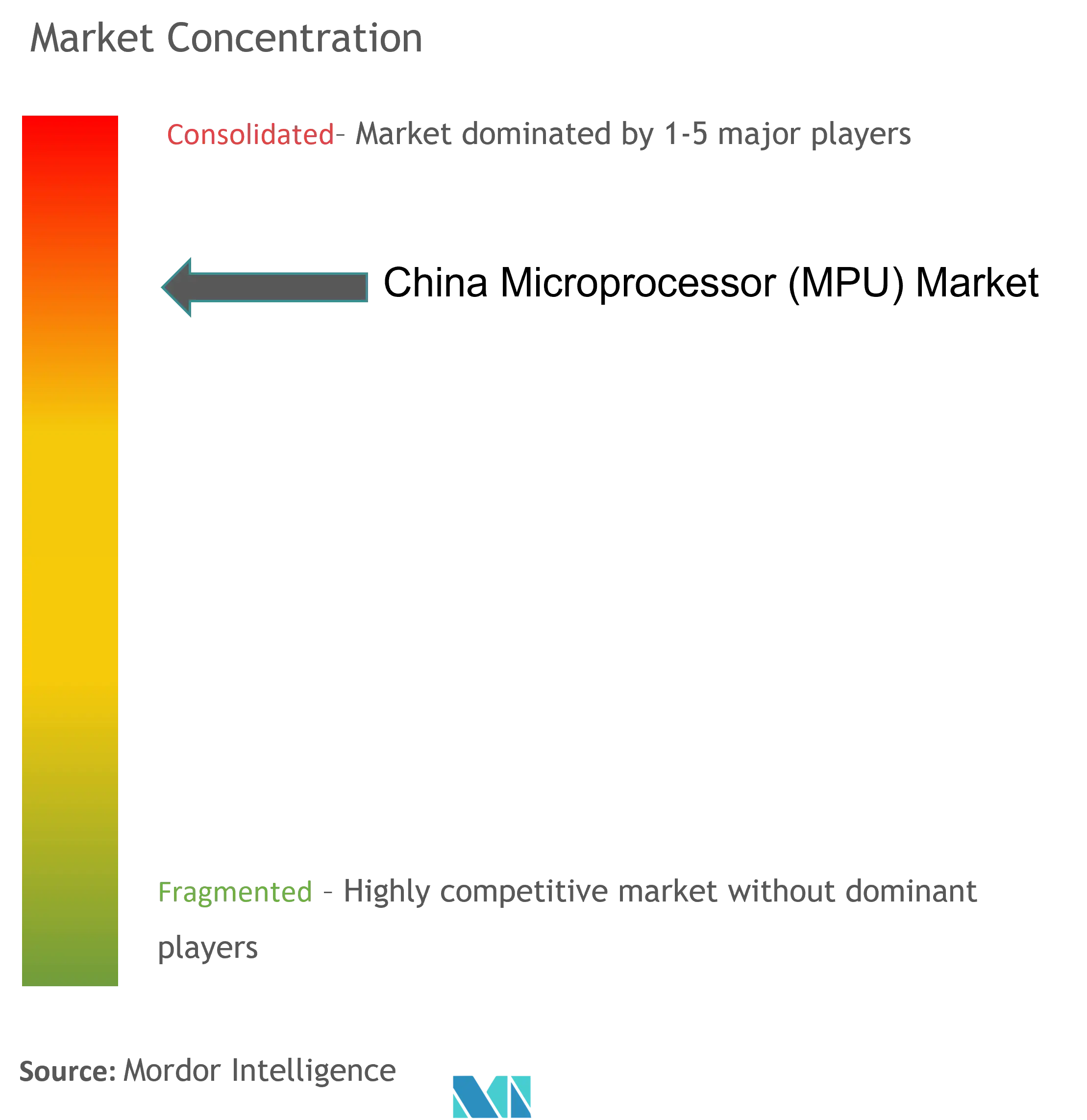China Microprocessor (MPU) Market Analysis
The China Microprocessor Market is expected to register a CAGR of 8.34% during the forecast period.
The Chinese microprocessor (MPU) market was valued at USD 9.87 billion in the current year. It is expected to reach USD 16.51 billion, registering a CAGR of around 8.34% during the forecast period. The market is expected to witness an increase in demand at the global level owing to the growing use of microprocessors in consumer electronics, such as smartphones, personal computers (PC), and laptops.
- China is assisting the market's growth due to a number of factors, including an increase in digitization, a rise in the use of high-tech devices, and the development of automotive electronics, among others. Additionally, it is anticipated that rising cloud service demand, massive government IT spending, and increased Internet of Things (IoT) usage are expected to support market expansion in China.
- China is taking advantage of the chance to increase its level of microprocessor self-sufficiency and end the US and British companies' monopolies. The most recent effort by China to increase its chip self-sufficiency has focused on microprocessors, the brains of all modern electronics. Since 2022, an increasing number of Chinese chip design companies have substituted open-source RISC-V for Intel's proprietary X86 and Arm's architecture in their chip designs in an effort to reduce the potential harm from US sanctions and save money on licensing fees.
- Chinese internet companies like Alibaba and Baidu have been manufacturing their chips. This is seen as progress toward China's goal of boosting domestic technological capacity. Due to ongoing trade issues and geopolitical considerations, China is working toward chip and semiconductor self-sufficiency. In its 14th five-year plan, China identified seven technological sectors, including artificial intelligence, quantum computing, semiconductors, and space.
- Additionally, a number of new companies in China are rushing into the semiconductor industry, according to Semiconductor Industry Association. Chinese companies registered as semiconductor enterprises number almost 15,000. Many of these new businesses are fabless start-ups with a focus on higher-end chip design, such as GPU, EDA, FPGA, and AI computing. Many companies create cutting-edge chips and design and manufacture devices using cutting-edge process nodes.
- According to SIA projections released in November 2022, China's market share of global chip design will increase from 9% in 2020 to 23% by 2030 (compared to a US decline from 46% to 36%), a significant rise but still far from world-beating. The development of chip design will soon enable Chinese businesses to grow. Such growth is likely to boost the Chinese microprocessor (MPU) market.
- On the other hand, it is anticipated that over the upcoming years, factors like high raw material prices, declining shipments of individual computers, rising sales of low-cost mobile devices, high manufacturing costs for microprocessor integrated circuits, and low-priced mobile device shipments will impede the market growth.
China Microprocessor (MPU) Market Trends
Rapidly Growing Demand for Smartphones and Tablets Expected to Fuel the Market Growth
- Consumer demand for smartphones and tablets is expected to proliferate during the forecast period, driving market expansion. A microprocessor boosts a smartphone's speed and effectiveness, which enhances the device's performance. The performance of the microprocessor in any smartphone is directly related to its speed.
- Getui predicts that the size of the Chinese market for 5G smartphones has been growing since 2022, along with the number of active 5G smartphones and market share. The market share of 5G smartphones increased to 38.7% by the end of 2022 from 28.0% at the end of 2021, a growth of 38.2% over the previous year.
- Additionally, with the rise of smart devices, electronic products like televisions, digital cameras, laptops, and wearable devices offer a variety of advanced technologies like flat screens, touch screen monitors and displays, and Bluetooth, which call for more integrated circuits (ICs) and microprocessors.
- Furthermore, microprocessors, which are present in all smartphones, enable them to carry out a variety of functions, such as making phone calls, sending text messages, browsing the internet, and using different apps. Smartphones' growing power and capabilities are also due to the incorporation of microprocessors in these devices.
- Additionally, smartphones are now more functional and appealing to consumers due to microprocessors, which made it possible for them to connect to the internet. Email, social media, and online shopping are just a few examples of the uses for smartphones' microprocessors that are made possible by the ability to connect to the internet.
Automotive Sector Expected to Boost the Microprocessor Market in China
- Microprocessors were initially designed for use in personal computers and servers. These ICs are now utilized in automotive applications, like infotainment systems and advanced Driver-assistance systems (ADAS), to improve connectivity and speed to vehicle systems. The rise in ADAS systems is bringing the demand for microprocessors in the automotive market.
- However, the market volume of sensors in ADAS technologies installed in newly assembled light vehicles in China is anticipated to increase, according to QUBE by just-auto.com. Additionally, it is anticipated that in 2033, the Chinese market for ADAS technology sensors for newly assembled light vehicles is expected to reach almost 1.43 billion units. Such a rise in sensors will also boost the demand for ICs and microprocessors.
- Additionally, China's automakers combat supply chain chaos with internal chips. For instance, Geely Holding Group declared in February 2022 that it had begun producing China's first automotive-grade seven-nanometer system-on-chips. The SE1000 chip was developed by Siengine, a partnership between Geely's EcarX in China's Hubei province and ARM Holdings in the United Kingdom. The ongoing semiconductor shortage that had plagued the global automotive industry since the previous year was something Geely hoped the new business would help to address. It would help the Chinese microprocessor industry.
- Furthermore, Beijing wants China to stop depending on foreign corporations and take a leading role in the global economy. In order to achieve this, it established the National Integrated Circuit Industry Investment Fund, also known as the Big Fund, which has invested in 2,793 entities, the majority of which are semiconductor companies. The Big Fund holds a minority stake in 74 businesses and a total of 74 companies.
- As a result, China has seen a rise in domestic chip companies as Beijing attempts to cut ties with American advanced technology and manage sanctions risks. Chinese semiconductor companies, supported by venture capital, are vying to offer the best alternatives to Nvidia and its contemporaries in the hotly debated field of autonomous driving. Zeekr, the premium electric vehicle brand of China's largest private automaker Geely, was one of the first to sign up. When the chip is put into mass production in 2025, Zeekr intends to use Drive Thor. These elements could increase China's demand for microprocessors.
China Microprocessor (MPU) Industry Overview
The Chinese microprocessor (MPU) market is significantly consolidated due to limited players in the market, which are even mostly global players. American firms dominate advanced chip design. The chips are mostly manufactured in China, but high initial investments are required to manufacture microprocessors. Some of the key players in the market are Intel, Texas Instruments, Qualcomm, AMD, etc. Some recent development in the market includes:
- December 2022: Loongson started shipping its 3C5000 processor, which features 16 LA464 cores with LoongArch microarchitecture, up to 64MB of cache, and four 64-bit DDR4-3200 memory interfaces with ECC support. The Loongson 3D5000 combines two 3C5000 CPUs on a single piece of the substrate to create a 32-core processor with eight memory channels. The 32-core processor supports up to 4-way simultaneous multiprocessor configurations, allowing for the construction of a server with up to 128 cores.
- August 2022: Semiconductor Manufacturing International Corporation (SMIC), China's largest chipmaker, is said to have made a significant breakthrough. SMIC's technology had advanced to a quasi-7 nm (nm) process, which could be a stepping stone to a true 7 nm process. SMIC's most advanced chip process node successfully manufactured in the past was 14 nm, though it has consistently made strong efforts to move toward an advanced process node (below 10 nm).
China Microprocessor (MPU) Market Leaders
-
Advanced Micro Devices (AMD), Inc.
-
Microchip Technology Inc.
-
Intel Corporation
-
Qualcomm Technologies Inc.
-
Texas Instruments
- *Disclaimer: Major Players sorted in no particular order
China Microprocessor (MPU) Market News
- November 2022: Loongson Technology manufactures MIPS-compatible microprocessors. Loongson announced that the 3A6000, its next-generation Godson CPU, would begin sampling with customers in the first half of 2023. According to Loongson, the 3A6000 would outperform AMD's Ryzen 5000 and Intel's 11th-Gen Core CPUs.
- May 2022: Zhaoxin, a Chinese microprocessor manufacturer, began providing the services after Intel Corporation and Advanced Micro Devices Inc. (AMD) stopped chip shipments to Russia. Russian motherboard manufacturers use the same microprocessors and designs as American manufacturers. Zhaoxin also planned to launch newer products that would compete with its global counterparts in some ways. Semiconductor Manufacturing International Corporation (SMIC), China's largest chipmaker, would manufacture its KX-7000 processors on the 7 nm process.
China Microprocessor (MPU) Industry Segmentation
A microprocessor is an electronic component integrated into a single integrated circuit (IC) containing millions of small components that work together, such as diodes, transistors, and resistors. This chip performs a variety of functions, including timing, data storage, and interaction with peripheral devices. These integrated circuits are found in a wide range of electronic devices, including servers, tablets, smartphones, and embedded devices.
The Chinese microprocessor (MPU) market is segmented by product (8-bit, 16-bit, and 32-bit or greater) and by application (consumer electronics, enterprise - computers and servers, automotive, industrial, and other applications). The market sizes and forecasts are provided in terms of value (USD) for all the above segments.
| By Product | 8-bit |
| 16-bit | |
| 32-bit or Greater | |
| By Application | Consumer Electronics |
| Enterprise - Computers and Servers | |
| Automotive | |
| Industrial | |
| Other Applications |
China Microprocessor (MPU) Market Research Faqs
What is the current China Microprocessor (MPU) Market size?
The China Microprocessor (MPU) Market is projected to register a CAGR of 8.34% during the forecast period (2025-2030)
Who are the key players in China Microprocessor (MPU) Market?
Advanced Micro Devices (AMD), Inc., Microchip Technology Inc., Intel Corporation, Qualcomm Technologies Inc. and Texas Instruments are the major companies operating in the China Microprocessor (MPU) Market.
What years does this China Microprocessor (MPU) Market cover?
The report covers the China Microprocessor (MPU) Market historical market size for years: 2019, 2020, 2021, 2022, 2023 and 2024. The report also forecasts the China Microprocessor (MPU) Market size for years: 2025, 2026, 2027, 2028, 2029 and 2030.
Our Best Selling Reports
China Microprocessor (MPU) Industry Report
Statistics for the 2025 China Microprocessor (MPU) market share, size and revenue growth rate, created by Mordor Intelligence™ Industry Reports. China Microprocessor (MPU) analysis includes a market forecast outlook for 2025 to 2030 and historical overview. Get a sample of this industry analysis as a free report PDF download.

